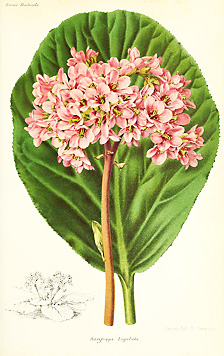Hardy Heartleaf
By Audrey Stallsmith

“I think of those evenings in the room filled with bergenia plants, with a tiny coal fire going and our accented voices taking turns in telling each other stories.”
Heart Matters, Adrienne Clarkson
It’s tempting to believe that the plants mentioned in the quote above actually should be begonias, but I’m guessing it would be possible to grow bergenias indoors. They apparently can take both low light and less than ideal conditions.
I can’t say for sure, since I’ve always intended to try bergenias, but never have gotten around to it. The glossy-leaved plant is one of those which often gets crossed off my list in favor of more exotic species. Fortunately, I received seeds of Bergenia crassifolia (“thick-leaved”) in a recent plant trade for free, and intend to sow some this spring.
The common name, “heartleaf,” makes the plant appropriate for Valentine’s Day, and it can be in bloom by February in mild climates. However, that nickname applies mainly to the cordifolia variety, which translates to “heart-shaped foliage.” As you can see from the Bergenia pacumbis image above, other species have rounder leaves. (I'm guessing pacumbis means "thick umbels," but don't quote me on that!)
One of bergenia’s other appellations, “pigsqueak,” sounds less than complimentary. However, it actually refers to the noise you can make by rubbing your fingers over the shiny foliage. The plant also has been called elephant-eared saxifrage and large rockfoil, due to its kinship with saxifrage. It’s genus name is a tribute to German botanist Karl August Van Bergen.
As mentioned above, bergenia can flower in winter where snow is uncommon, its foliage often acquiring striking red, bronze or purple hues during the colder months. Hardy to zone 3, it probably won’t bloom until April here in Pennsylvania. That's just as well, since it likely would be covered by drifts before then!
The plant’s rosette of leaves seldom exceeds one foot in height, but its cluster of bell-shaped blooms may stand taller. The most common color is pink, though there are red, white, and purple varieties available as well.
"Discovered" by Georg Gmelin in Siberia during the early 1700s, bergenias often are used medicinally in eastern Asia for their anti-inflammatory and astringent qualities. In those parts, their tannin-rich leaves also sometimes serve as a subsitute for tea. Here, they most often are employed as a shade-tolerant ground cover.
In Garden Flora, Noel Kingsbury confirms that the plants also were used "as winter pot plants for cool conservatories beginning during the 1890s in England and Germany." So perhaps you could, indeed, bring them indoors to join your circle of loved ones by the fire on dark winter evenings.
The Bergenia pacumbis image is from Revue Horticole, courtesy of plantillustrations.org.








